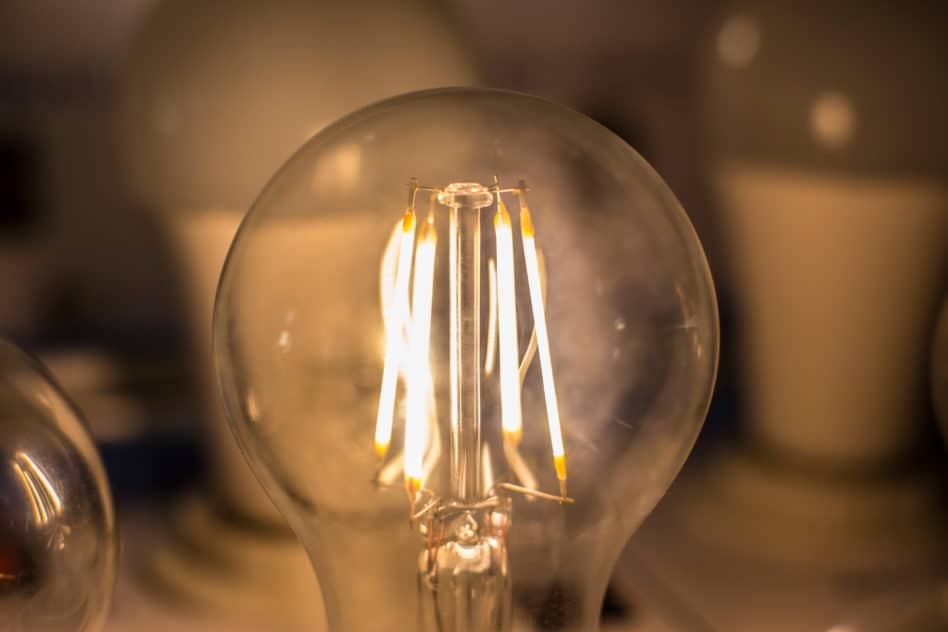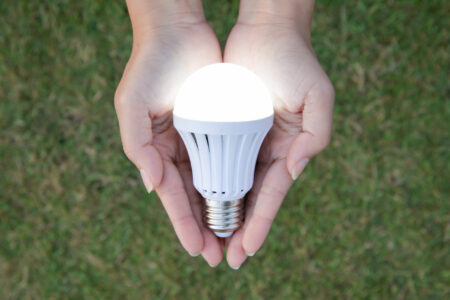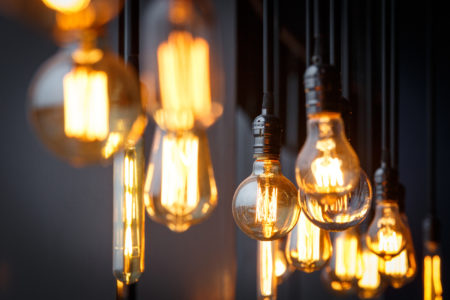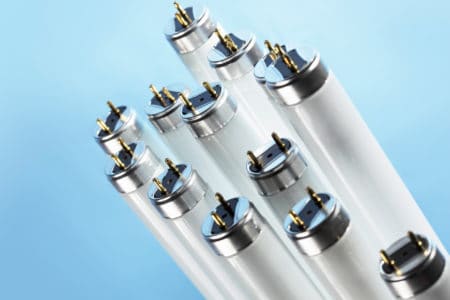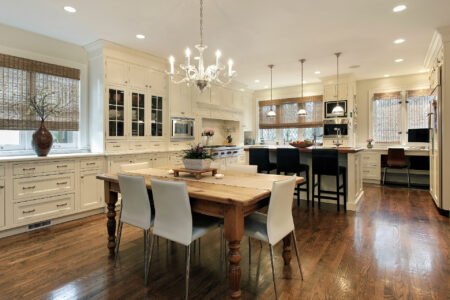Since some time you can find so-called LED filament bulbs in many stores and shops. These have no single light emitting diodes inside their glass bulb. Instead one or more filaments are integrated. But what is the advantage of these filament lamps? In this article you will learn the differences between classic LED lights and the new filament bulbs.
What are LED filament bulbs?
For some time now, new light sources with LED filaments have been offered on the market. In general these are retrofit lamps. Also the following terms can be found frequently:
- Filament lamp
- Filament bulb
- LED filament
- Incandescent light bulb
All terms mean something similar and are often used as a synonym for the new LED generation. For a better understanding you should understand the difference of the individual terms.
LED filament
The LED filament is a narrow strip, on which individual LEDs are applied in a row. Sometimes it is also referred to as a incandescent filament. This is very uncommon with LEDs, since the incandescent filament is actually only contained in the conventional incandescent light bulbs.
LED filament bulb
An LED filament bulb is a light source that contains the filaments described above. As with the well-known incandescent lamps, the LED filaments are usually housed in a glass bulb. This type of light source is often referred to as an LED filament lamp or simply as a filament light source.
Functionality of the filament lamps
The new generation of filament lamps in retro design has been on the market since 2015. Until then some technical challenges had to be solved with the construction and the function of the filament.
Structure of the filament
The filament consists of a transparent glass carrier in strip form. Several light emitting diodes are arranged on it. These are COB LEDs without housing. About 30 of the compact LED chips can be placed on a 40mm long glass carrier. The individual LEDs are connected in series and connect to the two outer contacts of the filament.
On a filament mostly blue and some red LEDs are used. The entire strip is then coated with a fluorescent layer. This provides the yellow color of the filaments. The ratio of blue to red LEDs and the composition of the coating make it possible to achieve any desired color temperature between cold white and warm white.

Structure of the filament bulb
The LED filament bulb looks very similar to the well-known incandescent bulb. Instead of the tungston filament you can now find the LED filaments in the bulb. Depending on the brightness to be achieved, 2 to 8 filaments are placed in the bulb. During the initial development of filament lamps, the power dissipation and the associated cooling of the LED chips posed a problem.
Due to the increasing efficiency of LED technology, heat dissipation is now limited. No extra heat sinks are required for the efficiency currently available. The LEDs on the filament initially dissipate their waste heat directly to the glass substrate. Inside the glass bulb there is a filling gas with good thermal conductivity, which transports the heat loss from the filament to the glass bulb.
Power supply
For operation, a filament requires a DC voltage between 60 and 80V depending on the number of LEDs installed. Depending on the number of filaments in the glass bulb, the individual filaments are often connected in parallel or in series. A small power supply unit is located in the socket of the bulb to generate the required string voltage.
Advantages of filament bulbs
With the LED filament bulbs a new generation of retrofit lamps has come onto the market. This makes it easy to convert existing luminaires to the latest LED technology. In addition to the advantages of previous LED retrofits, the filament lamps also have other benefits:
- Classic design
- Compact dimensions
- Spherical radiation
Classic design
After more than 100 years of living with the classic light bulb, many people do not like the sometimes very futuristic designs of modern LED lights. Here the LED filament bulbs are a good compromise.
Filament lamps combine the advantages of current LED technology with the classic design of the light bulb.
Compact dimensions
The basic idea behind LED retrofits is the simple replacement of old light sources with LED light sources of the same design. However, many retrofit LEDs have larger dimensions than their predecessors. This is especially true for versions with higher lumen output, where large heat sinks are necessary.
The filament LEDs are available with the same dimensions as the classic light bulb despite their high power. This means that they can also be used in cramped luminaires where previous retrofits were too large.
Spherical radiation
When purchasing LED illuminants, you should always pay attention to the specified radiation characteristics. In previous retrofit lamps, lenses and reflectors were used to achieve an almost spherical radiation. This light distribution is also referred to as omnidirectional.
LED filament bulbs have an almost spherical distribution of the generated light due to the construction and arrangement of the filaments. The light distribution is very similar to that of a incandescent bulb to be replaced.
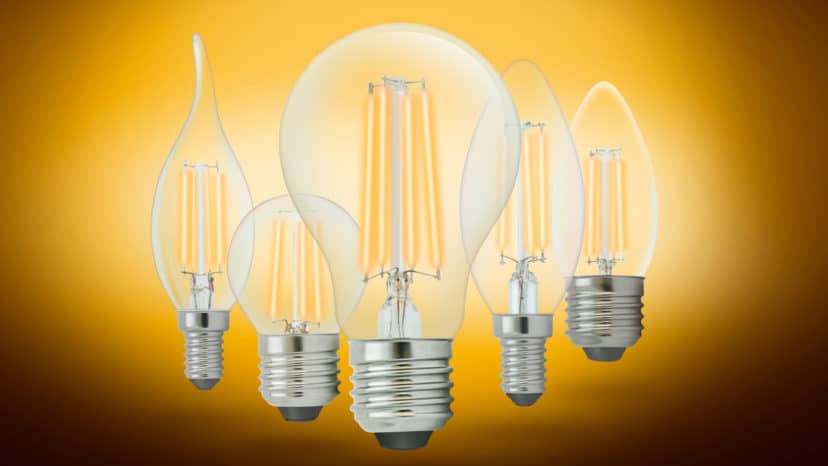
What filament types are available?
Due to the elongated nature of the filament and the spherical light distribution, filaments are primarily suitable for illuminants with large glass bulbs. LED filaments are therefore most frequently found in light sources with E26 and E14 sockets.
LED filament for E26 socket
In E26 filament bulbs usually 4 to 8 filaments are used. These are offered with different bulb shapes. In addition to various bulb shapes, there are also versions in globe, vintage or drop shape.
LED filament for E14 socket
In E14 filament bulbs usually 2 to 4 filaments are used. These are offered with different bulb shapes. In addition to various candle shapes, there are also variants in globe, drop or tube shape.
Are filament LEDs dimmable?
In order to dim LED lights, certain conditions must be met. On the one hand, the dimmer must be suitable for LEDs due to its mode of operation. The LED light source must also be labelled as dimmable. This applies to all LED luminaires and light sources. The brightness of an LED filament can always be adjusted. However, the ballast unit integrated in the socket must also be designed for this.
Dimming LED filament bulbs
For the filament lamp to dim properly, it must be marked as dimmable. The used dimmer must also be designed for LED operation.
Conclusion
Filament bulbs are a new generation of LED light sources on the market. The filament lamps come with the design of an old incandescent lamp. Nevertheless, they have all the advantages of the current LED technology. Their dimensions are the same as those of their predecessors so they can be used in almost any luminaire.
